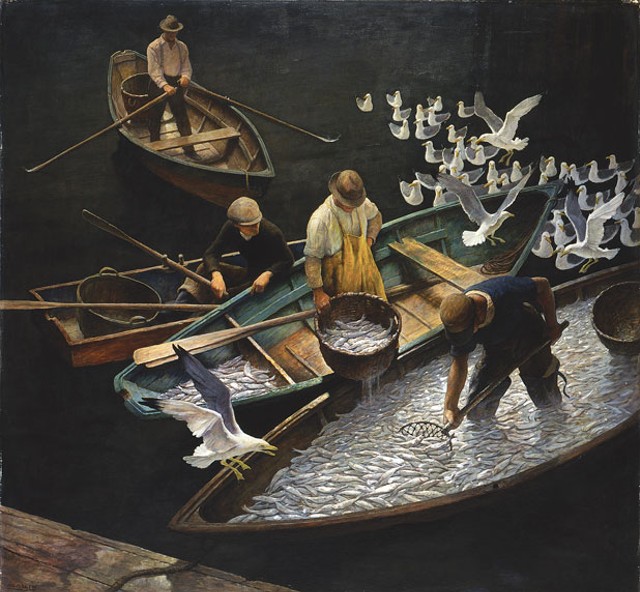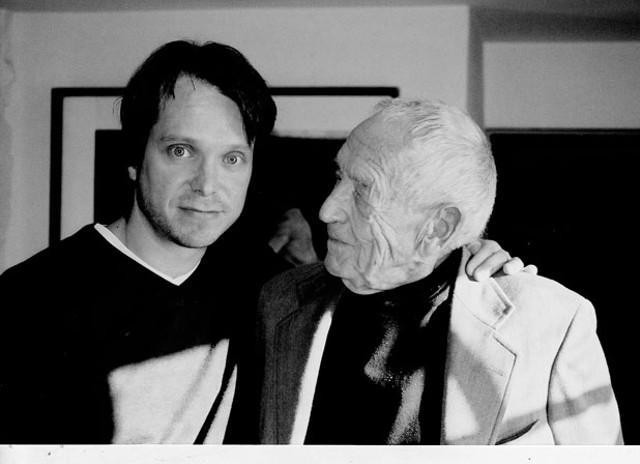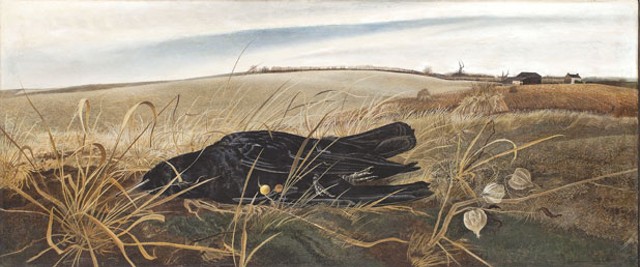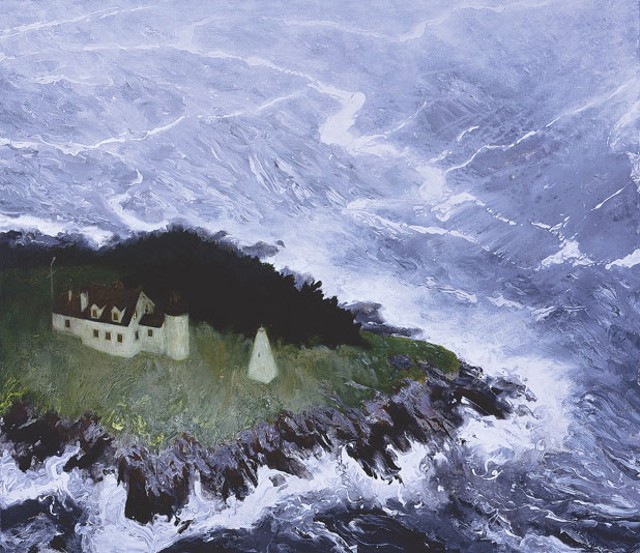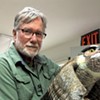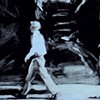Published July 24, 2013 at 11:17 a.m. | Updated October 16, 2020 at 5:05 p.m.
Death. Danger. Dizziness. Those are key concepts in the optical roller coaster that is “Wyeth Vertigo,” a highly stimulating exhibit at the Shelburne Museum this summer. And if the name “Wyeth” calls to mind only “that painting with the woman crawling up the hill,” you probably haven’t seen it yet. There is so much more to know. Not just about Andrew Wyeth (1917-2009) — whose iconic “Christina’s World” is, in fact, not in the show — but also about his father, Newell Convers (1882-1945), and about his son, Jamie (born 1946).
“Wyeth Vertigo” presents paintings by three generations of a great American art family whose output spans the 20th century and continues in this one. Each painting compels — and rewards — close viewing. But this is not only a selection of interesting artworks. The curatorial thesis itself is singular and fascinating: namely, that all three artists seem obsessed with disorientation, and that is manifested in their paintings as extreme perspectives.
This commonality gives viewers an overarching quest in the exhibit: to find their “You are here” equilibrium in relation to each picture, and then to contemplate, perhaps, why each artist chose such a swoony aspect. In his review of the exhibit, Boston Globe critic Sebastian Smee likens the process to trying to solve a crime, quoting Edgar Degas’ directive that “One must paint a painting as one commits a crime.”
It’s not entirely clear what Degas meant by his simile — perhaps a go-for-broke passion for the task at hand? Whatever. In Smee’s view, the “crime” in “Wyeth Vertigo” is one that can’t be solved. But the clues can be examined — no, experienced — one painting at a time, and the sensation of discovery is oddly satisfying. To recognize the pull of a Wyeth painting is to be more, not less, deeply enthralled. And the disquieting effect is not the lurching stuff of midway rides but a subtler, deeply emotional force.
The Wyeths don’t achieve their unusual perspectives by sleight of hand or optical illusion but by sheer skill. “To train his son’s imagination and agility of viewpoint, N.C. had Andrew draw a skeleton from every conceivable angle and then took it away, demanding that he draw it from memory,” writes Joyce Hill Stoner in the exhibition catalog. Stoner, the director of the preservation studies doctoral program at the University of Delaware, has been the Wyeth family conservator since 1997. It was her visit to Shelburne a few years ago to examine the museum’s painting “Soaring,” by Andrew Wyeth, that instigated this exhibit.
During that visit, writes museum director Tom Denenberg in the catalog’s foreword, Stoner observed the Wyeths’ “predilection for paintings that look down, up, in, and out of odd spaces. This vertiginous sense of space serves to make the viewer ill at ease — at times literally dizzy,” Denenberg continues, “and complicates our understanding of paintings that appear conventional on the surface but can be interpreted in a multitude of ways.”
“Soaring,” the 47-by-87-inch tempera painting purchased by museum founder Electra Havemeyer Webb in 1960, is not just the show’s genesis but a stunning example of its theme. First, it has a swirling, bird’s-eye-view perspective. In the foreground, a turkey buzzard spreads its wings high above broad, nearly featureless Pennsylvania fields. Two other buzzards float slightly beneath it. The birds of prey seem to be circling a tiny, vulnerable-looking white farmhouse far below. But the artist’s and viewer’s,vantage point is even higher than that of the highest bird, an impossible perspective unless you’re in a plane or … you’re another bird. And if so, critic Smee quips, “Must we consent to having such a deplorably ugly head?”
Then again, we could interpret this scene metaphorically: think bomber pilot. Andrew Wyeth began “Soaring” during World War II, abandoned it because his father dismissed the painting, and finally finished it in 1950, well into the Cold War. Paranoia and the possibility of danger from the sky were real. The catalog accompanying “Wyeth Vertigo” does not suggest that Andrew wanted us to overlay his picture with geopolitical significance, but it does note that he was “fascinated with height and flight.” (By the way, the painting was finished two years before Daphne du Maurier’s story “The Birds” was published, and 13 before Alfred Hitchcock’s adaptation seared the menacing avian image into filmgoers’ minds.)
Just as significant is that the turkey buzzard in “Soaring” is beautifully, meticulously painted. As family legend has it, Andrew kept a dead specimen in his studio for more than a week, sketching it repeatedly. Several of those framed studies are displayed with the painting in the Shelburne’s exhibit and further demonstrate Andrew’s extraordinary skill as a draftsman. The dry, unforgiving medium of tempera, his palette of dull browns and the almost sinister sense of foreboding are also characteristic of his work. These stand in contrast to the gooshier watercolors and oils, and vivid color preferences, of both N.C. and Jamie.
Not all of Andrew’s perspectives are from on high; in “Winter Fields” (tempera, 17.25 by 41 inches, 1942), the eye level might be that of a worm or insect. A dead crow lies on the ground in the foreground, as black as an oil slick and painted with exacting detail, as are the sepia-colored botanicals surrounding it. A small farmhouse is tucked into the horizon line across a vast, brown field. Everything seems dead … and yet we can’t look away. It is, as Denenberg puts it, a “remarkable” painting.
“Wyeth Vertigo” is rich in landscapes from the family’s turf in Chadds Ford, Pa., and in dramatic seascapes from their island home off the coast of Maine. Yet one of the most alluring paintings in the exhibit is a 2001 interior by Andrew that could almost be European and medieval. Almost.
Titled “Sparks,” the tempera is large, nearly four feet square, and reiterates Andrew’s earthy palette. The work manipulates perspective in several ways. The subject is ostensibly the enormous, ungrated hearth and the fire burning within it. But the rear of the fireplace is a gaping, inky hole, like a cave you might fall into. A receding grid of square floor tiles draws the eye toward this central feature, and there’s a palpable sense of needing to duck your head: A dark beam along the low ceiling juts toward the viewer.
Adding to the claustrophobic feel is a dark wood wall in the right foreground, on which hangs a smaller painting. Momentarily distracted by it, a viewer of this exhibit may notice that the work is a mirror-image replica of an actual watercolor, “Wolf Moon,” hanging just feet away.
Then, as you are inexorably drawn back to the painted hearth and begin to wonder about the unseen source of illumination from the left, your eye may alight on a small, previously unnoted item: a red-and-white L.L.Bean bag on the floor of the painted room. The casual but jarring detail snaps you back to present time and makes you smile. Andrew Wyeth has tricked you again.
According to Stoner, the Wyeth challenge extended from art into social life. “The Wyeths are always testing you when you visit — it is a bit like Alice in Wonderland or [Through] the Looking Glass,” she writes in an email. “If Andy said, ‘May I refill your drink?’ that meant [his wife] ‘Betsy wants you to leave now.’
“Jamie might put a taxidermy squirrel in the oven and then ask you to check the roast and watch how you react,” Stoner continues. “You are always being quizzed on art or current events, or asked to react to their newest paintings.”
She concludes, “Truth is not always what it seems — in their homes or in their paintings.”
“Winter Fields” by Andrew Wyeth
If three generations of Wyeths liked to “throw people off balance,” as Stoner puts it, we might ponder whether the pattern is learned or encoded in the family’s DNA. Nature or nurture? Obviously, each artist could and most likely did learn from the others — both artistically and socially. But perhaps each artist, too, had his own reason for being a provocateur.
For his part, N.C. was a gifted illustrator who achieved a measure of fame with his paintings for such books as Treasure Island, yet he always wanted to be a fine artist. He was certainly a vicarious adventurer. “N.C. was kind of larger than life,” as Denenberg puts it. He was born too late to belong to the “manly man era” of Theodore Roosevelt, Denenberg says. Yet the subjects of N.C.’s paintings “From an Upper Snow Platform” and “The Eight Miners” — both from 1906 — depict men struggling heroically against nature. The testosterone seems all but mixed into the pigment.
These paintings also enhance their death-defying scenes with, yes, vertiginous angles. Will the men dig their way through the steep snowbanks, or will an avalanche bury them alive? The perspective alone creates a suspenseful narrative.
The threat of death and actual death recur in N.C.’s work. In one of his most chilling paintings, “The Drowning” (42-by-48-inch oil, 1936), an empty rowboat drifts on waves that lap at a dramatically rendered spit of land — its leaning, abstracted trees show N.C.’s experimentation with modernist styles. A murky shape in the water suggests the grisly fate of the boat’s former occupant.
N.C.’s work for children’s texts is no less unsettling. In “Just as the Baby’s feet cleared the ground,” a 45-by-24-inch oil from 1923, an eagle dangles a small blond child from its claws, wings upswept for takeoff. Simultaneously, a huge wolf leaps up to lock its jaws around the bird’s neck. The viewer/artist is at ground level, looking up helplessly. The baby may have been saved, but the image is still terrifying.
More satisfying as works of art are N.C.’s genre paintings of fishermen at their quotidian occupation — works that reveal what Denenberg calls the artist’s “infatuation” with Winslow Homer. Particularly gorgeous is N.C.’s “Dark Harbor Fishermen” (35-by-38-inch egg tempera, 1943). Here the viewer has a towering advantage looking in on a close-cropped scene of men and small boats. One man stands knee deep in a dinghy filled with silvery fish, his job apparently to scoop them up with his long-handled net and deposit them in the cauldron-size basket held by another fisherman. All of the men are closely watching this process, and all are wearing hats, which from the viewer’s angle obscure their faces. A cluster of seagulls, too, is riveted by the sight of all those fish. These details render the scene intimate, the viewer somewhat voyeuristic.
N.C.’s use of tempera here — along with a seemingly luminescent pigment for the fish — makes one wonder: Did he learn about this then-modern paint from his son? Or was it the other way around? Andrew Wyeth’s 1944 “Night Hauling” is nearly pitch-black, its lobster thief barely illuminated by bioluminescent organisms twinkling in the water. Either way, N.C.’s genre scene has a flat, black sea and richly saturated colors, contrasting with the glowing fish. It was four years before Jackson Pollock painted the seminal “Phosphorescence” in his transition to drip painting.
Jamie Wyeth surely benefits from the family name, yet, like any child of a famous parent, he treads a path littered with great expectations. For an artist of lesser talent, these obstacles would be crippling. But the works in “Wyeth Vertigo” demonstrate how the grandson of N.C. and son of Andrew has made his way — and made the Wyeth quirk of odd perspectives his own.
Born in 1946 — among the first batch of baby boomers — Jamie shows more contemporary sensibilities. Like his father, though, he has eschewed trendiness. And like both his artistic forebears, he embraces the macabre, but he has more fun with it. Jamie is also more self-referential than his elders, but not directly. Witness “Pumpkinhead-Self Portrait,” in which he wears a black coat from one of the Wyeths’ infamous Halloween parties, his head replaced by a jack-o’-lantern.
Jamie is fond of portraying animals, and while he doesn’t anthropomorphize them, exactly, he sort of becomes them. Denenberg is of the opinion that the ram in “The Islander” (34-by-44-inch oil, 1975) is a psychological portrait of the artist, who is devoted to the isolated Southern Island he calls home and fiercely protective of his privacy. Notorious for painting en plein air inside a cardboard box to elude visitors, Jamie creates that close-quarters perspective in “Winter Pig” (25-by-36-inch watercolor, 1975). The artist is sitting inside the pigpen, looking — with his pig — out its door at a snowstorm. The exterior whiteout makes the pen seem cozy rather than, well, penned in.
Jamie’s deep connection to his island is evident in numerous coastal paintings. And his respect for the region’s elements is nowhere clearer than in “Spindrift (40-by-46-inch oil, 2010). The artist’s perspective surveys the island as if from a high cliff, or the viewpoint of a gull. The white house at the island’s center seems imperiled by an angry, roiling sea. The scene is no less terrifying than are Jamie’s grandfather’s images of endangered mine workers or babies snatched by eagles.
“Spindrift” by Jamie Wyeth
Perhaps the most “Wyeth-y” of Jamie’s paintings in this exhibit is “Comet,” a 48-by-40-inch oil from 1997. The perspective is that of a seagull resting in the foreground, while a lighthouse dominates the center of the composition, sitting on the horizon line. Clouds squiggle across the early-evening sky and almost obscure the tiny comet. It’s a mere speck in the picture, yet Jamie gives it title status, as if to underscore both the dramatic natural phenomenon and our failure to take notice of it. We humans, in this case, are represented by the indifferent seagull.
As with the works of N.C. and Andrew, Jamie seems to invite viewers to step into his point of view — but not necessarily to stay. “Wyeth Vertigo,” indeed.
When Electra Havemeyer Webb purchased “Soaring” in 1960, Andrew Wyeth was on her short list of artists whose works she wanted to collect. According to a previous museum administrator, Denenberg writes in his foreword, Webb regarded Wyeth as “one of the greatest, if not the greatest, artist of our time; American, that is.” If that qualifier spoke to the interests of one of the greatest collectors of her time, it also signaled the museum founder’s evolving direction — from folk and decorative arts to modern ones.
Unfortunately, Webb died later that year and did not get to pursue the names on her list. But the acquisition of “Soaring” proved prescient. Not only did her approbation precede a shift in critical thinking about Andrew Wyeth’s place in American art history, but, 53 years later, the painting would engender a world-class exhibit at her beloved museum called “Wyeth Vertigo.”
Finally, Webb’s step toward contemporary art will find fresh expression at the brand-new, year-round Pizzagalli Center for Art and Education, which opens next month on the museum’s campus.
For now, viewers have a chance to contemplate the radical difference a change of perspective can make, artistically, viscerally and psychologically. Asked why people should come to this exhibit — all self-serving reasons aside — Denenberg muses for a moment. Then he points out, “Not all exhibits have a thesis. But, thanks to Joyce, this is a smart show. It adds to the conversation, and that’s what museums should do.”
“Wyeth Vertigo” is at the Shelburne Museum through October 31. Info, 985-3346. shelburnemuseum.org
The original print version of this article was headlined "Looking Up, Looking Down."
Andy and Me
Burlington artist and cartoonist Harry Bliss was such a passionate Andrew Wyeth fan that, back in 2004, he wrote Wyeth a letter to tell him so. “I told him how much his work meant to me, and sent him a kids’ book I had just finished,” says Bliss, whose cartoons appear in the New Yorker and Seven Days. “He sent me a sweet letter back, saying he had one of my New Yorker cartoons in his studio and, when he was having a bad day, it cheered him up.
“His response gave me some sense of my place in the world,” Bliss adds, still humbled.
Wyeth, then about 87, told Bliss to come by and visit him if he was ever in the Chadds Ford, Pa., area. On a book tour not long after this exchange, Bliss was in the ’hood and stopped by.
“I had an armful of cartoon sketches,” Bliss recalls. “He asked me about Vermont and my family. He and his wife, Betsy, and I just sat and shot the shit. I eventually whipped out about 30 or 40 cartoons, and we laughed and had a great time. Andy really liked my drawing.”
At some point, Betsy had to run out for errands — but gave Bliss a pair of her hand-knitted wrist-warmers and snapped a photo of the two artists before she departed. “As soon as Betsy left, Andy told me what an amazing woman she was,” Bliss remembers. “And he said that when he had first proposed an illustration for the Saturday Evening Post, the editor wanted him to do 10 a year — essentially to become the magazine’s illustrator.”
But, Wyeth told him, “Betsy said, ‘You can’t do that — you are not meant to be an illustrator.’”
“So,” says Bliss, “Andy said no to the Saturday Evening Post. That was turning down a lot of money … [Betsy] took care of the business.”
Why was Bliss so inspired by Andrew Wyeth, whose works were never really au courant?
“I still can’t believe there wasn’t more praise for him,” he replies. “Aside from being remarkably skilled, there’s a somber tone in all his work that just resonates with me. There aren’t always figures [in the paintings], but there’s a jacket, a paint can, as if someone had just left. It’s just emotionally charged.”
His uncle, a fellow artist, Bliss adds, also admired the reclusive Wyeth. “When I told him I’d been to see Andrew Wyeth, he couldn’t believe it! ‘How did you do that?’” Bliss imitates. “‘Andrew Wyeth turned down an invitation to see President Kennedy!’”
Bliss counts himself lucky, indeed. “They were so sweet to me — I couldn’t believe how kind and giving they were,” he says. “Andy showed me this pencil sketch he was working on, this beautiful drawing of just Betsy’s hands while she was knitting.”
In turn, Bliss gave Andrew Wyeth the original of that New Yorker cartoon on his wall. The drawing was based on a classic Norman Rockwell illustration for the Saturday Evening Post depicting an overall-clad farmer seeing his son off to college. Except in Bliss’ version, the characters are rabbits, and the father says to the son: “Your mother wanted you to have this. It’s her foot.”
More By This Author
Speaking of Art
-

Q&A: Catching Up With the Champlain Valley Quilt Guild
Apr 10, 2024 -

Video: The Champlain Valley Quilt Guild Prepares for Its Biennial Quilt Show
Apr 4, 2024 -

Q&A: Meet a Family in Waterbury That Embraces Halloween Year-Round
Feb 14, 2024 -

Video: Goth Family in Waterbury: Sarah, Jay and Zarek Vogelsang-Card
Feb 8, 2024 -

Q&A: Art Entrepreneurs Tessa and Torrey Valyou Celebrate 15 Years of New Duds
Oct 11, 2023 - More »
Comments
Comments are closed.
From 2014-2020, Seven Days allowed readers to comment on all stories posted on our website. While we've appreciated the suggestions and insights, right now Seven Days is prioritizing our core mission — producing high-quality, responsible local journalism — over moderating online debates between readers.
To criticize, correct or praise our reporting, please send us a letter to the editor or send us a tip. We’ll check it out and report the results.
Online comments may return when we have better tech tools for managing them. Thanks for reading.


































